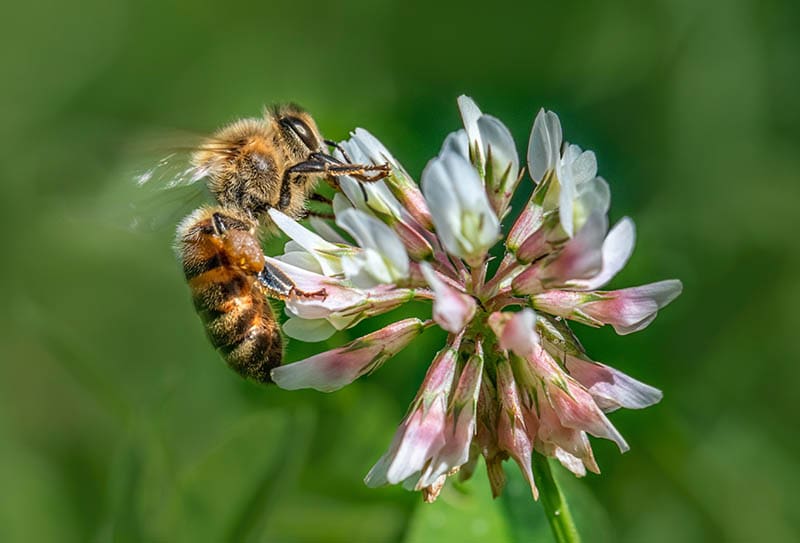What Is the State Insect of Vermont? Facts, History, & FAQ
-
Pete Ortiz
- Last updated:

Other than Iowa and Michigan, the remaining 48 U.S. states have all decided on and officially recognized a state insect. State insects are usually prevalent in the state where they are named and either offer some benefit or have some feature that in some way symbolizes the state or its people.
The state insect of Vermont is the honeybee. The honeybee is the official state insect of 19 states, making it the most popular state insect, and it is most commonly chosen for the benefits it brings to agriculture. While the honeybee is not native to Vermont, or the rest of the U.S., it has become significantly important to the crop-growing world. It was officially named Vermont’s state insect in 1978.
The Honeybee

The honeybee is not a U.S. native. It was introduced in the 17th Century from Europe. But, since then, it has become one of the country’s most beneficial insects. Not only does it produce sweet-tasting honey that is a popular food with humans and used for its medicinal properties, but it also helps pollinate many fruit and nut crops. It is estimated that honeybees increase the value of U.S. crops by $15 billion a year.
Bees in Vermont
Vermont is actually home to 350 different species of bees¹. While the bumblebee is arguably the most widely recognized, it is only the honeybee that can produce honey. They are kept commercially and there are also wild honeybees, although the total number of honeybees is declining.
Typical reasons for the decline include pollution, the use of insecticides in farming and horticulture, and infections and parasites.
Facts About Honeybees
Honeybees, and bees in general, have become vital to our survival. Pollinators, which include honeybees, are responsible for pollinating three-quarters of the world’s crops and 90% of wildflowers. They’re basically a free resource that can be used by farmers and gardeners to assist in their crop growing, but they are dying out. Other facts about honeybees include:
1. They Can Fly At 25 Kilometers Per Hour

Honeybees can flap their wings, of which they actually have four, up to 200 times per second, which helps them achieve speeds as high as 25 kilometers per hour.
2. Worker Bees Only Live a Few Weeks and Produce 1/12 of a Teaspoon of Honey
A hive or colony of bees has a hierarchical structure that is based on the role of the bees. At the head is the queen bee, which can live up to 5 years and lay more than 2,000 eggs a day. Worker bees are all female, and they go gathering pollen and nectar from flowers. They also protect the hive and by beating their wings, they help circulate air around the hive.
A worker bee will usually only live for around 6 weeks and make 1/12 of a teaspoon of honey in this short time. Drones are the male bees, and their responsibility is to mate with the queen. Drones are evicted from the hive in wintertime.
3. They Do a Waggle Dance

When honeybees return to their hive, they perform what is called a waggle dance. They move in a figure of eight while waggling their bodies. This shows the other bees the direction of a food source and is a vital means of communication between the members of the hive.
Do All States Have a State Insect?
Two states, Iowa and Michigan, do not have named state insects. The remaining 48 states all have at least one insect. The bumblebee is the official state insect of 16 states and the state agricultural insect of three more states.
What Is Vermont’s State Butterfly?
As well as having a state insect, Vermont has also named the Monarch Butterfly its state butterfly. It was named in 1987 after being proposed by schoolchildren from Cornwall Elementary School.
Conclusion
The honeybee was introduced to the U.S. in the 17th Century but has become integral to the country’s crop success. It is also vital to the pollination of wildflowers and plants and, of course, it produces the sweet honey that many people enjoy eating and that is used for its health benefits.
The flying pollinator was named Vermont’s state insect in 1978 and was joined in 1987 by the Monarch as the state butterfly.
- https://statesymbolsusa.org/symbol/vermont/state-insect/honeybee
- https://en.wikipedia.org/wiki/List_of_Vermont_state_symbols
- https://www.netstate.com/states/symb/insects/vt_honeybee.htm
- https://www.ereferencedesk.com/resources/state-insect/vermont.html
- https://www.usgs.gov/faqs/are-honey-bees-native-north-america
- https://birdwatchinghq.com/bees-in-vermont
- https://www.natgeokids.com/uk/discover/animals/insects/honey-bees/
- https://www.wwf.org.uk/learn/fascinating-facts/bees
Featured Image Credit: Daniel Prudek, Shutterstock
Contents


